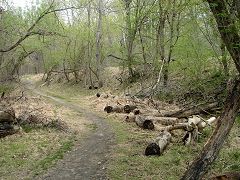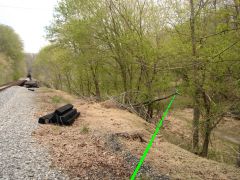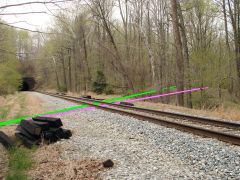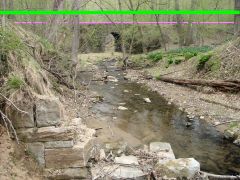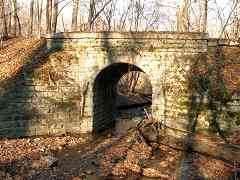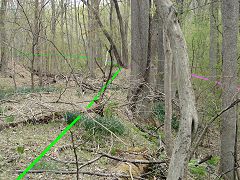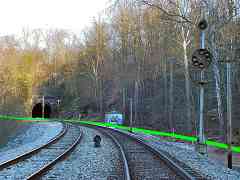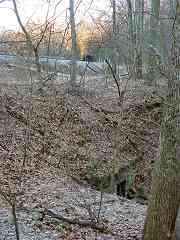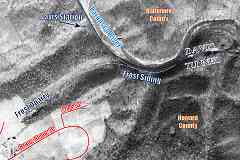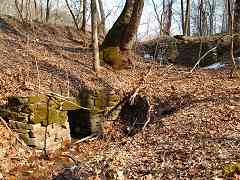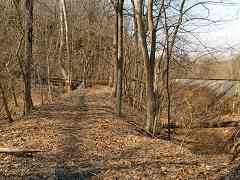|
In addition to the siding, this aerial photo from 1937 hints a short
stub peeled west from the siding, and curved toward the quarry, as traced
by the thin white lines. As reference, modern roads are sketched in red.
The shadowed area that would have resulted from digging into the hillside
is presumed to be the Frost Quarry; operation probably had ceased by the
time of this aerial photo. The marked location matches that in the
following description.
Edson S. Bastin's Economic Geology of the Feldspar Deposits of the
United States (USGS/Dept. of the Interior Bulletin 420) dated 1910
states of the Frost Quarry:
"The largest quarry in this region is about half a mile south of Davis
station and 1-1/2 miles southeast of Woodstock, on the Frost Farm, and
is operated by the Golding Sons Company of Trenton, N.J.
"This quarry is located in a pegmatite deposit of a character somewhat
different from those described above. In April, 1908, this quarry was
about 450 feet long by 100 wide by 65 in maximum depth, its greatest
dimension trending about N. 60° E. The feldspar is of two varieties...
"In this quarry a steam drill is used and a derrick is operated by a
hoisting engine. The material is hauled about a quarter of a mile to
the railroad and is shipped to Trenton, N.J. and Wilmington, Del."
A reader named John says:
"My statements below are derived from 'Minerals of the Washington, D.C.
Area'; by Lawrence R. Bernstein; 1980; Dept of Natural Resources; Maryland
Geological Survey; Educational Series #5; Pages 56, 57 and 58.
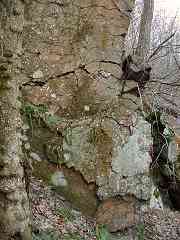
"I am certain the name 'Fannie R. Frost' siding is directly related to the
name of the quarry referenced in the above citation. The name of this
'abandoned' quarry is the 'Fannie Frost Feldspar Quarry'. It is located
approximately 1/3 of a mile South of the Old Main Line inside the Patapsco
State Park property close where your photo was taken.
"I frequently visit this area and often run into Geologists (pretty sure they
are hobbyists) searching for minerals like titanite at the quarry. According
to Bernstein, It was operated in the early part of the 20th century for
feldspar. I'm curious if/how/where items like feldspar from the quarry
where loaded onto the trains."
Reader Phil Stackhouse contributed the following historical background:
"Fannie R(isteau) Frost (1865-1957) was my
great aunt, sister to my grandmother Kate Frost Stackhouse and lived on and
managed the ancestral Frost farm which was adjacent to the railroad at that
location. So the simple answer may be that the siding was simply named for
the adjacent landowner. As you probably know, besides the station stops
along the Main Line, there were any number of 'flag' stops - called that
because the train would stop only if flagged down. They were used for both
passenger service and freight. There were also regular milk stops along the
route for the morning and evening milk trains going to Baltimore. One of the
regular flag stops on this section of the road was for the Frost farm and it
may be this location that gave the siding its name.
"I am intrigued by the reference to a Fannie Frost Feldspar Quarry. I know
the location of this quarry and from family stories, believe that stone was
shipped from it on the railroad. But I've never heard it referred to by that
name. Aunt Fannie was a school teacher by profession and while very capable
of running the farm as well, I suspect that she knew little of quarrying. I
grew up in an extended family on that property that included Aunt Fannie and
one of her sisters, but never heard them mention the quarry. She died in
1957 and as I was still fairly young at the time, don't remember all the
stories. I haven't been back to the quarry for many years and was surprised
to hear from your correspondent John that others even know of its
existence.
"It might also be of interest that my grandfather Samuel Dorsey Stackhouse
and his brother William were rail agent, postmaster and storekeepers at
Woodstock from 1881 until ca. 1887. Both of them married Frost sisters that I
am sure they must have met as customers in the store. I have all of the
store records for those years as well as the rail ticket sales records for
some."
| 